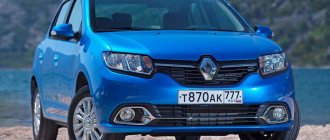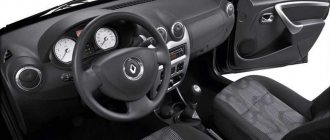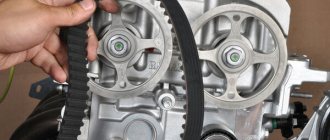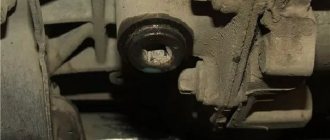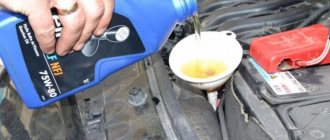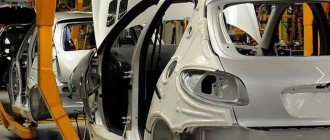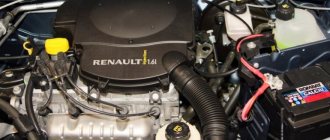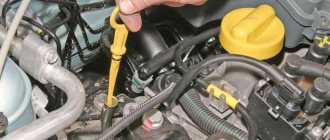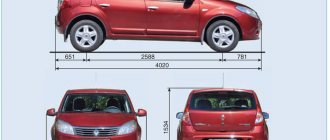Cylinder head of Renault Logan 1.6 8 valve engine
So, this version has the following technical characteristics:
- From a 1.6-liter capacity, the engine generates 82 hp. With.
- The maximum torque of this “giant” is 134 Nm.
- The unit fully complies with stringent European environmental standards Euro-5.
- The Renault Logan 2 engine has been known for a long period and will delight you with noticeable traction from the bottom, ease of repair and excellent service life of most main systems and components.
- The manufacturer regulates a resource of at least 200 thousand km for this engine. During this run (period), the 8-valve unit is not capable of presenting the owner with unpleasant surprises in terms of serious breakdowns.
This version has the following technical characteristics:
- A power of 102 “forces” is available for this motor.
- The maximum torque of which the unit is capable is 145 Nm.
- Acceleration dynamics are mediocre - 10.5 seconds (with manual transmission) to the first 100 km/h, but sufficient for comfortable movement and maneuvering.
- The Renault Logan 2 engine is not endowed with acute or chronic malfunctions, and its fuel consumption is very acceptable.
Technical characteristics of the chassis: its design has not undergone major modifications.
The front part has an independent suspension design, and at the rear there is a traditional and reliable beam with a stabilizer. Renault Logan 2021 shock absorbers have acquired new characteristics to ensure improved stability and sufficient smoothness on the road surface.
Brake circuits purchased:
- ventilated disc mechanisms on the front axle;
- “drums” for the stern axis.
• Displacement – 1598 cm3 • Number of cylinders – 4 • Number of valves – 8 • Cylinder diameter – 79.5 mm • Piston stroke – 80.5 mm • Timing drive – belt • Power hp (kW) – 87 (64) at 5500 rpm per minute • Torque – 128 Nm at 3000 rpm. per minute • Maximum speed – 175 km/h • Acceleration to the first hundred – 11.5 seconds • Fuel type – AI-92 gasoline • Fuel consumption in the city – 10 liters • Fuel consumption in the combined cycle – 7.3 liters • Fuel consumption on the highway – 5.8 liters • The engine has a long service life and is completely unpretentious. The main thing is to change the timing belt on time, which is perhaps the main weak point of the engine.
✔ low price and reliable engine design; ✔ reliability: confirmed service life is more than 400 thousand km; ✔ universal and repairable; ✔ easy to maintain; ✔ have high torque; ✔ good “elasticity” of engines is ensured, equal to 1.83.
✔ relatively high fuel consumption; ✔ there is instability in speed when idling; ✔ there are no hydraulic compensators in the design, so it is necessary to constantly adjust the valves (after 20-30 thousand km); ✔ there is a possibility of valves bending if the timing belt suddenly breaks; ✔ crankshaft seals often leak; ✔ low reliability of the cooling system; ✔ very noisy and prone to vibrations.
If all routine maintenance is carried out in a timely manner and in accordance with the manufacturer’s recommendations, then the engine life can reach 400 thousand km, which is confirmed by numerous real examples. The only unpleasant surprise may be a broken timing belt, as evidenced by reviews. In the event of such an accident, the pistons collide with the valves, causing them to bend or completely collapse.
Engine Renault Logan 1.6 8 cl. gasoline, four-stroke, four-cylinder, in-line, eight-valve, overhead camshaft. The operating order of the cylinders is: 1–3–4–2, counting from the flywheel.
— MPI distributed fuel injection. The engine, gearbox and clutch form the power unit - a single unit mounted in the engine compartment on three elastic rubber-metal supports. The right support is attached to the bracket on the top cover of the timing belt, and the left and rear ones are attached to the gearbox housing. The engine cylinder block is cast from cast iron, the cylinders are bored directly into the block. The nominal cylinder diameter is 79.5 mm.
At the bottom of the cylinder block there are five crankshaft main bearing supports with removable caps, which are attached to the block with special bolts. The holes in the cylinder block for the bearings are machined with the covers installed, so the covers are not interchangeable and are marked on the outer surface to distinguish them (the covers are counted from the flywheel side). On the end surfaces of the middle support there are sockets for thrust half-rings that prevent axial movement of the crankshaft.
The main and connecting rod bearings of the crankshaft are steel, thin-walled with an anti-friction coating applied to the working surfaces. Crankshaft with five main and four connecting rod journals. The shaft is equipped with four counterweights cast integrally with it. To supply oil from the main journals to the connecting rods, there are channels whose outlet holes are closed with plugs. At the front end (toe) of the crankshaft there are installed: an oil pump drive sprocket, a timing gear drive pulley and an auxiliary drive pulley. In the hole of the toothed pulley there is a protrusion that fits into a groove on the toe of the crankshaft and secures the pulley from turning. The drive pulley for auxiliary units is similarly fixed on the shaft.
Renault Logan 1.6 is cast from aluminum alloy, common to all four cylinders. It is centered on the block with two bushings and secured with ten screws. A non-shrinking metal gasket is installed between the block and the head. There are five camshaft supports (bearings) located at the top of the cylinder head. The supports are made one-piece, and the camshaft is inserted into them from the timing drive side. The camshaft is driven by a toothed belt from the crankshaft.
In the outer support journal of the camshaft (from the flywheel side) there is a groove into which a thrust flange fits, preventing axial movement of the shaft. The thrust flange is attached to the cylinder head with two screws. The valve rocker axis is attached to the camshaft supports with five bolts. The rocker arms are kept from moving along the axis by two brackets, which are secured with bolts securing the rocker arm axis. Screws are screwed into the rocker arms, which serve to adjust the thermal clearances in the valve drive 5.
The adjusting screws are prevented from being loosened by locknuts. The valve seats and guides are pressed into the cylinder head. Oil deflector caps are placed on top of the valve guides. The valves are steel, located in two rows, inclined to the plane passing through the cylinder axes. At the front (along the direction of the car) there is a row of exhaust valves, and at the rear there is a row of intake valves. The intake valve plate is larger than the exhaust valve.
Currently reading: Not enough Renault Logan engine
It opens with a rocker arm, one end of which rests on the camshaft cam, and the other, through an adjusting screw, on the end of the valve stem. The valve closes under the action of a spring. Its lower end rests on the washer, and its upper end rests on a plate, which is held in place by two crackers. The folded crackers have the shape of a truncated cone on the outside, and on the inside they are equipped with persistent flanges that fit into the groove on the valve stem.
Renault Logan engine lubrication combined. The main and connecting rod bearings of the crankshaft and the camshaft bearings are lubricated under pressure. Other engine components are splash lubricated. The pressure in the lubrication system is created by a gear oil pump located at the front of the oil pan and attached to the cylinder block. The oil pump is driven by a chain drive from the crankshaft.
The timing drive on Renault Logan 1.6 8 valves is carried out according to the following scheme (image just above) - torque from the crankshaft pulley is transmitted to the camshaft pulley, rotating the coolant pump pulley. The belt is tensioned with a special roller, which changes along with the timing belt. If the belt breaks, the valve bends.
Therefore, in accordance with the vehicle maintenance regulations, we check the condition of the belt every 15 thousand km. The surface of the toothed part of the belt should not have folds, cracks, undercuts of teeth and separation of fabric from rubber. The reverse side of the belt should not have wear, exposing the cord threads, or signs of burning. There should be no delamination or fraying on the end surfaces of the belt. The belt must be replaced if traces of oil are found on it. Regardless of the condition of the Renault Logan timing belt, it must be replaced every 60 thousand kilometers.
Engine Renault Logan K7M 710 1.6 l. 86 hp nothing more than a regular K7J 1.4 liter, only with an increased piston stroke (from 70 to 80.5 mm), of course the height of the block has increased slightly, the clutch has a larger diameter, the flywheel has been enlarged and the shape of the gearbox housing has changed. Structurally, Logan's 1.6 liter engine, like its low-volume brother, has the same archaic design from the middle of the last century with rocker arms and a strange oil pump drive system from lower-end Renault engines of the 60s. In spite of everything, with careful attitude to the engine, service and maintenance, changing the oil 2 times more often than according to the instructions, it is very, very reliable, according to internal factory data, the service life of the Logan 1.6 engine is about 400 thousand km, in practice the engine traveled a little more . In 2010, the K7M 710 was replaced with the K7M 800, the engine was strangled, brought up to the Euro-4 environmental standard, the power decreased to 83 hp, and no design changes occurred.
The disadvantages of the K7M are the same as those of the K7J 1.4 engine, high fuel consumption, the speed often starts to float at idle, valves need to be adjusted constantly (once every 20-30 thousand km), there were no hydraulic compensators and there are no timing drives It’s belt driven, if the belt breaks in the Logan 1.6, the valve bends, so we change the belt every 60 thousand km. Still the same crankshaft oil seal leaks. The motor is noisy and there are vibrations. On the design of the Renault Logan 1.6 engine and where the engine number is located, information is presented in the article “K7J engine”, which, apart from the volume and accompanying changes, has no other changes. All malfunctions and the reasons for their occurrence are also described there. Speaking about which engine for Renault Logan is better, 1.4 or 1.6 8 valve, take 1.6... the engine is the same, but the small volume is very weak.
Also, on the basis of the K7M, the K4M engine was created with a 16-valve cylinder head and other significant innovations, the power of such an engine is significantly higher and if you choose (for example, Logan, Sandero), always take it, you won’t regret it.
For the Logan K7M 800 engine, you can remove the catalyst, return it to its original power of 86 hp, install an exhaust and flash the sport firmware, maybe add a couple more horses, but nothing will change significantly, except fuel consumption, now your engine will eat more.
- Equipment
- Specifications
Specifications
| Body | |
| Body type | sedan |
| Number of seats | 5 |
| Number of doors | 4 |
| Transmission | |
| Drive unit | front |
| Transmission | mechanical |
| Number of gears | 5 |
| Engine | |
| Volume | 1.6 (1598 cm 3) |
| engine's type | petrol |
| Engine location | front transverse |
| Injection type | distributed injection |
| Number of cylinders | 4 |
| Valves per cylinder | 2 |
| Rated power | 62 kW / 84 hp (at 5500 rpm) |
| Max. torque | 124 Nm (at 3000 rpm) |
| Gas distribution mechanism | DOHC |
| Cylinder arrangement | in-line |
| Cylinder diameter | 79 mm |
| Piston stroke | 80 mm |
| Compression ratio | 9.5 |
| Wheels | |
| Front tire | 185 / 65 / R15 |
| Rear tire | 185 / 65 / R15 |
| Spare wheel | full size |
| Front discs | 15″ |
| Rear discs | 15″ |
| Dimensions | |
| Height (mm) | 1534 |
| Length (mm) | 4288 |
| Width (mm) | 1740 |
| Ground clearance (mm) | 155 |
| Wheelbase (mm) | 2630 |
| Front wheel track (mm) | 1481 |
| Rear wheel track (mm) | 1470 |
| Turning diameter (meters) | 10,5 |
| Minimum trunk volume (liters) | 510 |
| Maximum trunk volume (liters) | 510 |
| Weight | |
| Curb weight (kg) | 980 |
| Gross authorized weight (kg) | 1540 |
| Dynamic characteristics | |
| Aerodynamic drag coefficient | 0,36 |
| Maximum speed | 175 |
| Acceleration time to 100 km/h | 11,5 |
| Fuel consumption | |
| Urban cycle (l/100 km) | 10 |
| Country cycle | 5,9 |
| Mixed cycle | 7,3 |
| Fuel tank capacity | 50 |
| Recommended fuel type | AI-95 |
| Price | 402,000 rub. |
We don’t grow old at heart
Even brand experts sometimes cannot answer how many years this model has existed. The first generation of Renault Logan began its history back in 2006, when the concern finally decided to create an ultra-low-cost family car that would be distinguished by both high reliability, efficiency and a long service life.
I must say that the French really succeeded. At first there were a lot of rumors about how many engines are supplied to Renault Logan, and what potential they have. Thus, a line of gasoline engines with a volume of 1.4 and 1.6 liters was born, which have a similar design and operating principle and differ in power precisely due to their volume.
How many valves are there? For the first generation, the engine running on Renault Logan has only 8 valves in total. True, the third Renault Logan engine subsequently appeared, in which the number of valves doubled and reached 16. The engine life, according to Renault Logan engineers, is not regulated.
However, practice has shown that the answer to the question of how long a motor runs without major repairs is clear. After 300 thousand kilometers, investments cannot be avoided. In addition, soon after the model entered the market, it became clear that one of the weak points of all power units was the crankshaft liners, which, as it turned out, should be changed every 50,000 kilometers. Otherwise, the Renault Logan engine begins to knock and requires expensive and time-consuming repairs after 100,000 km.
Currently reading: Renault Logan engine - 1.4 or 1.6 and which engine is better, 8 or 16 valve
The 1.4 engine has a power of 75 horsepower. Torque can be achieved at an operating speed of 4750 rpm and reaches 105 newton meters. The maximum speed is 162 km/h. At the same time, the sedan can accelerate to hundreds in just 13 seconds. Fuel consumption in the urban cycle is 9.2 liters, and on the highway this figure drops to 6.8.
The 1.6 engine for Renault Logan, whose power rating is 84 horsepower, reaches a torque of 115 Newton meters at 5000 rpm. The maximum possible speed of the car is 175 km/h, and acceleration to 100 km/h is 11.5 seconds. At the same time, in the city the car can consume no more than 10 liters, and outside the city - 7 liters per 100 km.
How much power does the 16-valve Renault Logan engine have? The motor supplied with the second phase of the Renault Logan has a power of 102 “horses” and reaches a maximum torque of 145 units already at 3750 rpm. The maximum possible speed is 180 km/h, and the car can accelerate to hundreds in just 10 seconds. Consumption - no more than 7 liters per 100 kilometers.
Engine and transmission Renault Logan
- The base engine of the Renault Logan is an in-line naturally aspirated petrol four with a volume of 1598 cubic centimeters. Due to the archaic structure of the gas distribution mechanism, it develops only 82 horsepower at 5000 rpm and 134 Nm of torque at 2800 rpm. With such a power unit, the sedan accelerates to hundreds in 11.9 seconds, and the top speed will be 172 kilometers per hour. Thanks to its small volume, the engine's appetite is very democratic. Renault Logan fuel consumption will be 9.8 liters of gasoline per hundred kilometers at a city pace with frequent acceleration and braking, 5.8 liters when traveling on a country road and 7.2 liters in a combined driving cycle.
- For those who want more interesting dynamics, Renault Logan offers another in-line four with a modern cylinder head structure. Thanks to two camshafts, engineers were able to squeeze out 113 horsepower at 5500 rpm and 152 Nm of torque at 4000 rpm. With such a power unit, the sedan accelerates to 100 km/h in 10.7 seconds, and the speed ceiling is 177 kilometers per hour. Modern technology has made this inline-four even more fuel-efficient. Renault Logan fuel consumption will be 8.5 liters of gasoline per hundred kilometers in urban conditions, 5.6 liters while driving on the highway and 6.6 liters in the combined driving cycle.
A look into the future
The concept of building a Renault engine remains the same. So, as before, they are naturally aspirated, four-cylinder, gasoline engine types that are transversely located in the engine compartment of the car.
How many options are installed on this sedan? If you open the official website of the manufacturer, the answer will become obvious: three. Their volume is 1.2 and 1.6 liters, while the latter can have a different number of valves. How many of them there are on a particular Renault Logan can be judged by the chrome sticker located on the rear edge of the trunk lid.
The lowest power unit has a power of 73 horsepower and a long service life. The engine runs about 400 thousand kilometers. The engine torque when reaching 4250 rpm is 105 units. The maximum speed of Renault Logan is 156 km/h, and acceleration is achieved in 14.5 seconds. Average fuel consumption is 7.8 liters.
The 1.6 engine has options with both 8 and 16 valves. The first Renault engine has a power of 82 horsepower and a torque of 115 units. For a 16-valve unit, these data are 102 hp and 145 nm, respectively. Fuel consumption in both cases is 8 liters per 100 km.
Summary
Renault engines are reliable units with a long service life and excellent performance. With proper care and timely maintenance, the car will last a long time and will not require large and unexpected investments from the owner.
Although the new Renault Logan has retained the general features characteristic of its predecessor, due to the implementation of a new exterior design, updates in the interior and the appearance of additional electronic assistants, it managed not only to maintain interest at a high level, but also to increase it subsequently, as well as its technical characteristics did not disappoint.
Reviews from specialists and car enthusiasts
According to a large number of expert owners, Renault Logan diesel has ideal ground clearance characteristics in its class. The ground clearance is able to provide optimal cross-country ability, and in addition, the station wagon meets the basic requirements for the maximum level of safety and comfort.
As shown by numerous reviews from owners who purchased a car this year and switched to a Renault diesel station wagon, this car demonstrates exceptional driving qualities.
The following qualities of the car were also noted:
- Ideal dynamics even at maximum engine speed.
- Optimal technical specifications.
- High levels of acoustic comfort at medium speeds and at fairly low speeds.
As positive reviews from owners show, the cabin provides ideal silence, which does not distract the driver’s attention from focusing on the road.
There is one single drawback that can be traced to Dacia by studying the reviews, and which is noted by almost all vehicle owners. This means that the station wagon requires only special high-quality diesel fuel. This is necessary to ensure long-term and efficient operation of the fuel system. This is the only point that can be classified as negative, as reviews from the owners have shown. A huge number of advantages inherent in the model cover this disadvantage.
The engineers who were involved in the development processes of the model were well aware of which highways the vehicle would have to travel on. Logan's front suspension, like that of Dacia, quite easily absorbs all the irregularities that are present on the road surface, moreover, even speed bumps. As reviews have shown, for Russian roads this is the best option, along with Dacia.
Applicability on cars
Budget car models Renault Logan 1.4 and Logan 1.6 have managed to win the recognition of many thousands of car enthusiasts over their almost ten-year history of presence on Russian roads. The concept of the French manufacturer, which decided back in 1998 to create an inexpensive and practical passenger car intended for developing markets, received the most triumphant continuation and unexpected development in Russia.
If in 2005 it all began at a small site of the Avtoframos enterprise in Moscow with the “screwdriver” assembly of several thousand cars per month, then today the Volzhsky Automobile Plant is building its annual plans, relying on the whole “Loganov” model scattering: Renault Logan, Renault Sandero, Lada Largus. Sales of these three models in the country in 2014 exceeded 160 thousand units.
To a large extent, such popularity of these Renault models was ensured by the use of proven and well-proven 8V single-shaft internal combustion engines (ICE) of the K7J 1.4 l and K7M 1.6 l series as power units. The flagship of the line for Renault Logan is considered to be a 16V four-cylinder liquid cooling unit with the index K4M, the production of which, in addition to the parent company Renault Espana, is also mastered at AvtoVAZ production sites.
Advantages and disadvantages of power units
Engine design K7J (manufacturer Automobile Dacia, Romania) 1.4 l/75 hp. inherited from fairly old Renault Corporation engines developed in the 80s (ExJ series) and therefore looks somewhat archaic: there is an unusual chain drive for the oil pump, used on units with lower camshafts, and ancient timing rocker arms.
The remaining solutions of the 1.4 engine are standard and no different from other four-stroke 4-cylinder single-shaft SOHC engines: in-line vertical cylinder arrangement, 2 valves per cylinder, timing belt drive, liquid cooling and a combined lubrication system (lubricant is supplied to the most loaded parts of the internal combustion engine under pressure, to all others - by simple spraying).
Engine Renault Logan K7M 710 and its successor K7M 800 (produced by the same Automobile Dacia) 1.6 l and 86 hp. (K7M 800 - 82 hp) are almost completely identical in design to the K7J, they are also liquid cooled, but have a piston stroke increased by 10.5 mm, obtained by changing the height of the block.
The greatest differences in design and characteristics are observed in the K4M engine, despite the fact that this internal combustion engine is 1.6 l and 102 hp. is also just another development of the K7M series. An all-new 16-valve cylinder head with two lightweight camshafts and a new piston system.
Here, finally, the need for constant adjustment of internal combustion engine valves over fairly short runs has been eliminated, eliminated by the simple use of well-known hydraulic compensators. The engine accelerates the car to 100 km/h in 10.5 seconds, reaching a maximum of 180 km - quite good performance. There are no obvious weak points in this unit: the necessary changes have been made to the system in terms of the pump and thermostat, and the ignition module has also been modified.
Considerable experience in operating Renault cars with all three types of liquid-cooled engines allows us to draw up a fairly objective picture of their strengths and weaknesses, and in the two models K7J and K7M these characteristics are almost identical, and only the K4M engine has significant differences due to more modern technological solutions, and which one is better is up to the buyers to decide.
Currently reading: Replacing the brake force regulator (replacing the sorcerer) Renault Logan Sandero: step-by-step instructions
Advantages of K7J and K7M:
- low cost and simplicity of engine design;
- reliability: confirmed service life is more than 400 thousand km;
- versatility and maintainability;
- ease of maintenance;
- high torque;
- good “elasticity” of engines, equal to 1.83.
Disadvantages of K7J and K7M:
- relatively high fuel consumption;
- instability of speed when idling;
- the absence of hydraulic compensators in the design, as a result - the need for constant adjustment of the valves (after 20-30 thousand km);
- “bending” of valves when the timing belt suddenly breaks;
- increased “fluidity” of crankshaft oil seals;
- poor reliability of cooling system elements;
- noisy and prone to vibration.
The advantages of the K7M model over the K7J include only an increase in maximum power by 12% and maximum torque by 11%. But the 1.6 liter internal combustion engine also pays for these advantages with an increased appetite of 4.5%, so which is better is a moot point.
- reliability, practical service life exceeds 400 thousand km;
- compliance with Euro-4 environmental standards;
- increased power (102 hp);
- low noise and vibration resistance;
- more modern and reliable cooling system.
Compared to 8-valve engines, the K4M 16V is much quieter, vibration-free and has the same service life, but significantly more power and torque.
Disadvantages of the K4M motor:
- expensive spare parts;
- “bending” of valves when the belt breaks;
- weak “elasticity” of the engine, equal to 1.53, as a result – problems with car acceleration when overtaking.
Thus, a detailed analysis of the technical characteristics of all three ICE samples, as well as practical experience in operating Renault Logan with these power plants, allows us to determine which engine is better. The more powerful 1.6 liter internal combustion engine with liquid cooling is still somewhat preferable to its “big brother” 1.4 liter.
Power 75 hp It’s simply not enough for comfortable driving of a loaded car, either on a country highway or during short “jogs” around the city. And in the debate between a 16V motor and an 8V motor, the first sample is the undisputed leader. The only characteristic in which 16V is inferior to its opponent is “elasticity”.
The 1.6 and 16-valve engine differs from the newest modifications; they are the absence of a mechanism for regulating valve timing; this engine design has significantly reduced the dynamic capabilities of the car. But the advantages remain excellent maintainability and durability, that is, increased engine life, thanks to simple design solutions from the manufacturer.
The engine is powered by a 1.4-liter 8-valve engine, which confirms the identical layout and similar design aspects of both engines.
The changes affected the following components and systems:
- the cylinder volume increased (1.6 liter engine), which made it possible to increase power in tandem with torque and improve the dynamic characteristics of the model;
- The output of the unit increased by 11% (up to 82 “horses” for the 8-valve version), this engine design led to an increase in torque to 132 Nm;
- the cooling system has undergone adjustments (the need for this modification is caused by an increase in engine power);
- the cooling circuit did not receive any fundamental design changes, and its elements were modified in order to achieve greater performance, for which some new components were integrated, which led to an increase in the service life and efficiency of the system, especially in critical operating modes;
- power increase up to 102 hp. With. achieved thanks to the use of new components in the cylinder-piston group units and valve mechanism:
- the number of valves has doubled (from 8 to 16), which ensured better filling of the combustion chambers with the mixture and led to an increase in power and dynamic capabilities;
- The service life of the motor has increased significantly due to the use of parts made of new, more durable alloys;
- After applying the previously mentioned design solutions in the updated engines, Renault Logan developers managed to achieve significant fuel efficiency:
- 1.5 liters at a distance of 100 km for a 1.6 engine with 16 valves;
- 1.0 liter in the case of 8-valve engine versions.
All these innovations made it possible to essentially make the 1.6 liter engine. more modern (especially the 16-valve version), the engine life has become longer. Although the developers did not apply progressive and innovative design solutions, this modernization of engines for Renault Logan still made it possible to attract a large army of new potential customers to the updated model.
In addition to design innovations, these units began to meet the requirements of Euro-5 environmental standards. In the future, the manufacturer of Renault Logan models planned to bring the engine design to the level of compliance with Euro 6/7 standards.
The update of the 1.6-liter unit was not limited to the use of a 16-valve cylinder head mechanism. The increase in traction and power characteristics was achieved thanks to significant transformations, including:
- increasing the performance level of the intake and exhaust systems, which was a necessary measure to bring engines to the advanced level of environmental standards;
- the use of new elements in the cooling circuit, which significantly improved the efficiency of its operation;
- replacement of the generator with a version of increased performance for the Renault Logan model, which made it possible to cope with increased loads on this unit (now the power varies depending on the model’s configuration)
Engine life of Renault Logan 1.6
Engines of the Renault Logan model, equipped with a cylinder capacity of 1.6 liters and characterized by two power options: 82 and 102 hp. pp., are the most common in the domestic car market among the entire list of modifications of this model. These motors have proven themselves to be reliable and repairable.
- reliability of elements in the cooling system;
- increased engine life;
- compliance of the maximum power indicator with modern trends in the automotive industry.
This is evidenced by numerous reviews from owners.
Technical characteristics of Renault Logan generation II
sedan 4-door
City car
- width 1,733mm
- length 4 346mm
- height 1,517mm
- ground clearance 155mm
- seats 5
| Engine | Name | Fuel | Drive unit | Consumption | Up to a hundred | Max. speed |
| 1.6 MT5 (82 hp) | Access | AI-95 | Front | 5,8 / 9,4 | 172 s | |
| 1.6 MT5 (82 hp) | Confort | AI-95 | Front | 5,8 / 9,4 | 172 s | |
| 1.6 MT5 (82 hp) | Privilege | AI-95 | Front | 5,8 / 9,4 | 11.9 s | 172 km/h |
| 1.6 MT5 (82 hp) | Luxe Privilege | AI-95 | Front | 5,8 / 9,4 | 11.9 s | 172 km/h |
| 1.6 RT5 (82 hp) | Confort | AI-95 | Front | 5,7 / 9 | 12.4 s | 164 km/h |
| 1.6 RT5 (82 hp) | Privilege | AI-95 | Front | 5,7 / 9 | 124 s | 164 km/h |
| 1.6 RT5 (82 hp) | Luxe Privilege | AI-95 | Front | 5,7 / 9 | 12.4 s | 164 km/h |
| 1.6 MT5 (102 hp) | Confort | AI-95 | Front | 5,8 / 9,8 | 10.2 s | 180 km/h |
| 1.6 MT5 (102 hp) | Privilege | AI-95 | Front | 5,8 / 9,8 | 10.5 s | 180 km/h |
| 1.6 MT5 (102 hp) | Luxe Privilege | AI-95 | Front | 5,8 / 9,8 | 10.5 s | 180 km/h |
| 1.6 AT4 (102 hp) | Confort | AI-95 | Front | 6,7 / 10,9 | 11.7 s | 171 km/h |
| 1.6 AT4 (102 hp) | Privilege | AI-95 | Front | 6,7 / 10,9 | 11.7 s | 171 km/h |
| 1.6 AT4 (102 hp) | Active | AI-95 | Front | 6,7 / 10,9 | 11.7 s | 171 km/h |
| 1.6 AT4 (102 hp) | Luxe Privilege | AI-95 | Front | 6,7 / 10,9 | 11.7 s | 171 km/h |
| 1.6 MT5 (113 hp) | Confort | AI-95 | Front | 5,6 / 8,5 | 10.7 s | 177 km/h |
| 1.6 MT5 (113 hp) | Privilege | AI-95 | Front | 5,6 / 8,5 | 10.7 s | 177 km/h |
| 1.6 MT5 (113 hp) | Active | AI-95 | Front | 5,6 / 8,5 | 10.7 s | 177 km/h |
| 1.6 MT5 (113 hp) | Luxe Privilege | AI-95 | Front | 5,6 / 8,5 | 10.7 s | 177 km/h |
Looking for reviews of Renault Logan? View reviews of Renault Logan
Let's sum it up
The considered power units with 8 or 16 valves are traditional for the French manufacturer of all models, including Renault Logan, and are unpretentious in operation and wear-resistant. In terms of dynamic characteristics, these engines are not “sports”, but they will not allow the owner to lag behind heavy traffic on the road.
Thanks to their balanced characteristics, engines with 8 or 16 valves have deservedly gained the trust of many Renault Logan car lovers. Their reviews are very, very positive. There were cases when engines failed after driving 100 thousand km due to defects in the crankshaft liners, but these precedents were not widespread.
Find out more about the new Logan
- Do-it-yourself PTF installation on Renault Logan phase 1 video
- installation of fog lights Logan | New Logan
- RENAULT LOGAN ELECTRICAL DIAGRAM - ELECTRICAL DIAGRAM | New Logan
- Electrical diagrams - Renault Logan / Renault Logan
- Replacing the Renault Logan clutch: instructions and features of the procedure | New Logan
- Replacing rear shock absorbers Renault Logan | New Logan
- Replacing the clutch cable on a Renault Logan: step-by-step instructions, necessary tools
- Do-it-yourself replacement of shock absorbers on a Renault Logan
Vehicle clearance and ground clearance parameters
The main advantages of Renault Logan, as reviews say, include ideal technical characteristics, unpretentiousness and high reliability indicators. The ground clearance for this brand is 170 mm, while for most European vehicles this parameter is exactly 150 mm. As is known, clearance parameters are calculated simultaneously for several points. For Renault Logan with a diesel engine, the body height relative to the road surface ranges from 155 mm to 185.
It is worth noting that, if necessary, the ground clearance can be changed by using rims of different sizes. Accordingly, if they turn out to be an order of magnitude smaller than those that come standard, the vehicle’s ground clearance will decrease slightly.
Despite the possibility of using wheels of different diameters, the ground clearance of a car of this brand is quite high. Depending on what components are installed on a given car, sometimes when measuring the distance from the highway to the lowest point of the body, it is approximately 200 mm. All these are indicators and characteristics of an unloaded vehicle.
The design features of the model with a diesel engine include the fact that the fuel filter and plastic tank are located quite high. At maximum load, Renault, whose rims have a diameter of 15 inches, has a ground clearance of 175 mm. Many people decide to install special spacers, but this can make the station wagon less stable on the track.
There is no need to increase the ground clearance on this model, even if the owner plans to constantly drive this vehicle on roads that are completely unequipped. A car of this type works well in places where other cars usually have problems. This is based on the fact that there is very reliable steel protection for the fuel and brake lines. The distance from the elements that relate to the protection of the engine from the front part to the stop of the shock absorber springs, which are located in the center, is optimal. This does not at all interfere with the efficient movement of the vehicle in relatively light off-road conditions.
